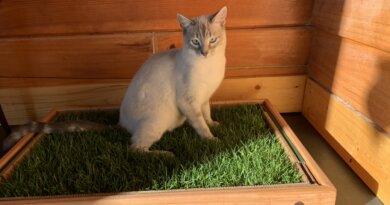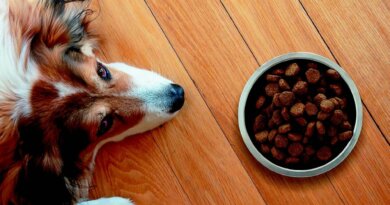Dealing with Disc Disease
“You know, saa-shaay! Her back end sways side to side, and she gets down real low in the rear. Sashay. Downtown dragging. You know, ‘Shawty got low, low, low.’ Not her normal Doxie dance.”
I was not being schooled on the hottest TikTok moves, but on the sudden sauntering style of a 5-yearold Dachshund dubbed Dorothy. Apparently, I wasn’t getting it.
“She starts doing this for no reason. She can be lying beside me, jumps down and then starts walking hunched up and dragging her hind end. If I touch her back she gets a little mouthy.”
To make her point, Dorothy’s mom pulled up a sleeve to reveal a nasty gash on her forearm slashed across an exceptional tattoo reproduction of Picasso’s “Lump” Dachshund.
Note to self: Avoid Dorothy’s pointy end while examining the posterior parts. Also, ask her mom who did her ink.
Disc Diseases
I immediately observed Dorothy was significantly weaker in her rear legs. I also noted a grimace as I approached her mid-back. My findings were quickly beginning to validate my initial concern: intervertebral disc disease.
Intervertebral disc disease (IVDD) is the most common canine spinal condition diagnosed by veterinarians.
Typical clinical signs are:
- Sudden weakness (paresis) or paralysis in one or both rear legs
- Intense localized pain along the backbone
- Difficulty urinating or defecating
- Reluctance to stand, walk or climb stairs
If the injury is in the neck region, all four legs may be involved. There are many conditions that can cause similar symptoms including trauma, arthritis, immune-mediated or infectious diseases of the spine, blood clots, neuromuscular diseases and tumors.
There are three types of IVDD veterinarians must distinguish between.
Hansen Type 1 IVDD occurs when part of the intervertebral disc, the protective “shock absorber” located between the spinal vertebrae, ruptures or protrudes, compressing the spinal cord running down the center. This causes severe pain and interferes with nerve transmission, resulting in weakness or paralysis. Type 1 is most frequently found in chondrodystrophoid (“short-legged” or “dwarf”) breeds such as Dachshunds, Corgis, Frenchies and Basset Hounds; dogs with genetic mutations CDDY or CDPA; and dogs with obesity. These injuries usually occur in the mid-back known as the thoraco-lumbar junction or “TL.”
Type 2 is more common in older, large breeds and is a progressive, usually nonpainful, disease that may lead to gradual hindlimb paralysis.
Type 3 are also called “acute non-compressive” or “missile discs” and often follow trauma or injury.
Diagnosis is made on medical history and physical exam, neurological tests, X-rays, and MRI or CT scans. I’ll be the first to admit that I consider any “sashaying sausage dog” to have IVDD until proven otherwise.
Testing and Monitoring
Dorothy’s mom had identified the problem early, and my tests revealed the presence of pain perception in both feet. I explained how the simple “pinch test” is important in determining how significant the spinal cord compression is in a dog. If a dog with suspected IVDD fails to withdraw his paw when the skin between the toes is squeezed, that is a sign surgery is needed urgently.
Another essential test is the “knuckle-over.” I gently bent the top of Dorothy’s paw so she was “standing” on it. Healthy dogs will immediately flip the paw back. Dogs with worrisome IVDD will either remain “knuckled-over” or very slowly return the paw to normal posture.
Finally, I emphasized the importance of monitoring for normal urine flow and pain-free bowel movements. Many dogs with IVDD will develop weak bladder function, putting them at risk for infection and complications. Other dogs will experience painful defecations, leading to constipation or worse. If Dorothy exhibited any changes in urine output or stream force, or cried or whimpered while going potty, she needed to come in at once.
Time for Treatment
Treating IVDD depends on the type, location, duration, severity and progression. Dogs who have become paralyzed or lost feeling routinely need immediate surgery to relieve the pressure on the spinal cord to eliminate pain and restore function. The longer a dog suffers from severe IVDD, the worse the chances of full recovery become. The majority of cases, especially when treated early, will improve with a combination of anti-inflammatory drugs, rehab and rest.

Help your dog shed some pounds with diet to help ease pressure on the spine.
Dorothy passed all her neurological tests, indicating likely mild disc protrusion and spinal compression. X-rays didn’t show any obvious spinal abnormalities, so we elected to delay a neurologist referral and MRI unless her condition worsened.
- I administered a potent anti-inflammatory injection and began class 4 laser therapy that day. We arranged for one of our veterinary technicians to treat her at home two to three times a week for the next four to six weeks.
- Strict rest and limited movement for the next two weeks was also stressed. Short, closely monitored leash walks to use the bathroom and sitting quietly in her mom’s lap or beside her were going to be her only activities until further notice. Dorothy had a comfy carrier her mom would make extra-cozy during recuperation.
- In addition, we would later initiate oral anti-inflammatory medication combined with an omega-3 fatty acid supplement.
- I also prescribed a weight-loss plan to help Dorothy shed a few unhealthy pounds that were adding pressure to her weakened spine. Because safe weight loss in dogs is about 70% diet and only 30% exercise, she could safely begin losing weight before increasing activity.
Immediate Treatment = Better Results
Within a week, Dorothy was pain-free. By one month, I okayed her to leave confinement, as long as she didn’t jump up (or down) or climb stairs. She had already lost a pound and was looking stronger each day. We continued laser therapy for another two months and maintained the Omega-3 DHA for life. I’m happy to report that Dorothy was back to normal within six months, albeit a bit slimmer and smarter! Dorothy’s mom attributed the vigor and vitality to the DHA joint health supplement; I credited the weight loss. We’re both probably right!
Prompt recognition and treatment allowed Dorothy to discontinue her “dragging” and resume her “Doxie dancing.” Back injuries need to be evaluated promptly for best results. If you think your dog is suffering from weakness or pain in the back or legs, or is “getting too low” or “dragging around,” contact your veterinarian immediately. And be sure to tell them this isn’t about TikTok.
Dr. Ernie Ward is an internationally recognized veterinarian known for his innovations in general small animal practice, long-term medication monitoring, special needs of senior dogs and cats, and pet obesity. He is the author of ‘The Clean Pet Food Revolution’ and has been a frequent guest on numerous TV programs.





I am in fact happy to read this blog posts which carries
tons of valuable facts, thanks for providing such data.
Hey I know this is off topic but I was wondering if you knew of any widgets I
could add to my blog that automatically tweet my
newest twitter updates. I’ve been looking for a plug-in like this for quite some time and was
hoping maybe you would have some experience with something like this.
Please let me know if you run into anything. I truly enjoy reading your blog and I
look forward to your new updates.
Asking questions are truly fastidious thing if you are not understanding anything completely, except this paragraph
presents pleasant understanding yet.
I have to thank you for the efforts you have put in penning this blog.
I really hope to see the same high-grade blog
posts by you later on as well. In fact, your creative writing abilities has motivated me to get my own, personal
blog now 😉
Hi i am kavin, its my first time to commenting anyplace,
when i read this article i thought i could also make comment due
to this sensible post.
After checking out a number of the blog posts on your website, I honestly like your technique of writing a blog.
I saved as a favorite it to my bookmark site list and
will be checking back soon. Please visit my web site
as well and tell me what you think.
Wonderful, what a web site it is! This webpage gives helpful information to us, keep it up.
Great article, totally what I needed.
This is really interesting, You’re a very
skilled blogger. I have joined your feed and look forward
to seeking more of your wonderful post. Also, I have shared your web site in my social networks!
Hello, i think that i saw you visited my site so i came to “return the favor”.I am trying to find
things to enhance my web site!I suppose its ok to use a few of your ideas!!
It’s amazing to visit this site and reading the views of all
mates on the topic of this piece of writing, while I am also eager
of getting know-how.
We’re a group of volunteers and starting a new scheme in our community.
Your web site provided us with valuable info to work on.
You’ve done an impressive job and our whole community will be grateful to you.